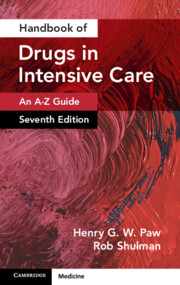Book contents
- Handbook of Drugs in Intensive Care
- Handbook of Drugs in Intensive Care
- Copyright page
- Dedication
- Contents
- Introduction
- How to Use This Book
- Common Abbreviations
- Acknowledgements
- Drugs: An A–Z Guide
- Chapter A
- Chapter B
- Chapter C
- Chapter D
- Chapter E
- Chapter F
- Chapter G
- Chapter H
- Chapter I
- Chapter K
- Chapter L
- Chapter M
- Chapter N
- Chapter O
- Chapter P
- Chapter Q
- Chapter R
- Chapter S
- Chapter T
- Chapter V
- Chapter Z
- Short Notes
- Appendices
- Drug Index
Chapter K
from Drugs: An A–Z Guide
- Handbook of Drugs in Intensive Care
- Handbook of Drugs in Intensive Care
- Copyright page
- Dedication
- Contents
- Introduction
- How to Use This Book
- Common Abbreviations
- Acknowledgements
- Drugs: An A–Z Guide
- Chapter A
- Chapter B
- Chapter C
- Chapter D
- Chapter E
- Chapter F
- Chapter G
- Chapter H
- Chapter I
- Chapter K
- Chapter L
- Chapter M
- Chapter N
- Chapter O
- Chapter P
- Chapter Q
- Chapter R
- Chapter S
- Chapter T
- Chapter V
- Chapter Z
- Short Notes
- Appendices
- Drug Index
Summary
Ketamine is a non-competitive antagonist of N-methyl-D-aspartate (NMDA) receptors and also binds to mu and kappa opioid receptors. It is licensed as an anaesthetic agent for diagnostic and surgical procedures and is best suited to shorter procedures. It has a role in the ICU as a co-analgesic, with opioid-sparing properties. It has good analgesic properties in subanaesthetic doses. Use of midazolam or another benzodiazepine as an adjunct to ketamine reduces the incidence of emergence reactions.
- Type
- Chapter
- Information
- Handbook of Drugs in Intensive CareAn A-Z Guide, pp. 171 - 173Publisher: Cambridge University PressPrint publication year: 2025

